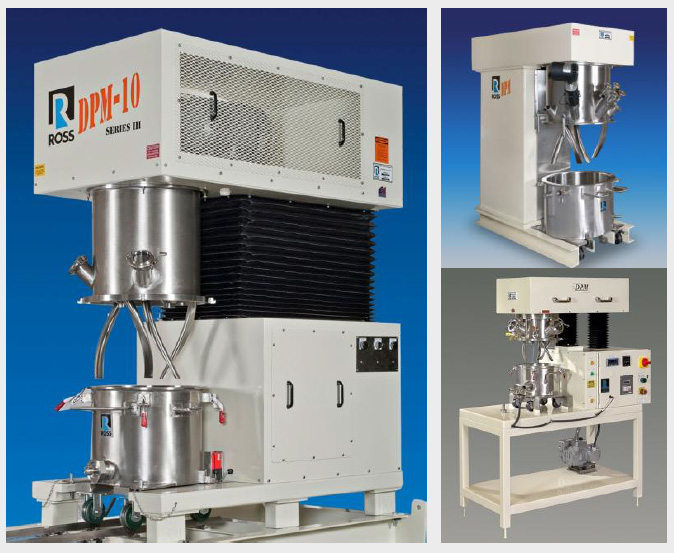Tech Report
Recommended Mixing Equipment for Silicone Elastomers
![]()
Application Summary
Silicone elastomers are highly versatile materials used in making various end products, from automotive gaskets and power cables to sanitary tubings and medical implants. Also commonly called silicone rubber, this type of elastomer consists of crosslinked silicone polymers typically filled with additives to achieve desired physical and chemical properties.
Silicone elastomers differ by curing mechanism as well as viscosity during processing. Mixer selection is based on a number of factors but primarily viscosity and shear input. The starting viscosity of the polymer base, the maximum viscosity reached by the mixture, and the final viscosity of the silicone rubber are all important considerations.
Ross Double Planetary Mixers
Room temperature vulcanizing (RTV) and high temperature vulcanizing (HTV) silicone elastomers are proven applications of the Ross Double Planetary Mixer. This type of mixer kneads viscous pastes or semi-solid gels by rotating two identical blades on their own axes as they orbit on a common axis. The blades contact virtually every point of the batch and impart a very thorough mixing action even when the product is not free-flowing. Heavy-duty Ross Double Planetary Mixers equipped with High Viscosity "HV" Blades (US Patent No. 6,652,137) are particularly ideal for handling peak viscosities up to 6 million cP.
A typical procedure begins with establishing a uniform consistency of the viscous base which could be a blend of two silicone polymers. Solid fillers such as fumed silica, microspheres, ceramic additives, carbon black or other pigments are then charged into the batch in increments. The low-viscosity crosslinker may be added slowly through a charge port as the agitators continue to rotate. Another option is the step-wise addition of components which involves pulling vacuum before mixing is resumed. This eliminates entrapped air within the mixture and helps ensure a void-free end product.
Due to the viscous and sometimes sticky nature of the finished batch, a Ross Discharge System is commonly used to quickly transfer the material out of the mix vessel, a technique that also enables easier clean-up between runs.
Other Typical Applications ofRoss Double Planetary Mixers:
- Abrasives
- Adhesives
- Battery Pastes
- Bone Graft Substitutes
- Conductive Inks
- Dental Composites
- Dilatant Materials
- Fiber Dispersions
- Filled Epoxies
- Granulations
- Heat Sink Compounds
- Lightweight Composites
- Lubricants
- Medical Pastes
- Metal Powders
- Molding Compounds
- Pharmaceutical Gels
- Plastics
- Potting Compounds
- Refractory Cements
- Sealants
- Syntactic Foams
- Toothpaste
- Viscous Foods

Some Advantages of Ross Double Planetary Mixerswith High Viscosity "HV" Blades
- Robust mixing power. The Ross Double Planetary Mixer can handle many ultra-high viscosity materials that previously required a double-arm kneader. It provides an alternative that is much less expensive and requires less maintenance. The helical curve and graduated down-thrust cross-section of the HV Blades prevent batch materials from "climbing" up into the mixer cover and charging ports. The smooth mixing action of the HV Blades also eliminates the torque spikes experienced in other planetary mixers equipped with conventional rectangular stirrers.
- Cleanability. There are no shaft seals, bearings, packing glands and stuffing boxes submerged in the product zone of the Double Planetary Mixer. Agitators are raised and lowered by a hydraulic lift allowing easy and complete access for cleaning.
- Change can design. This feature further reduces the risk of cross-contamination between batches while allowing for semi-continuous operation when one mixer is used with multiple vessels.
- Fast and easy discharge of highly viscous products. A Discharge System supplied with the mixer simplifies and accelerates the transfer of a non-flowable product after the mixing cycle. With the mix can positioned beneath the Discharge System, a platen is lowered hydraulically into the vessel. A specially-fitted O-ring rides against the vessel, virtually wiping the sidewall surfaces clean. Product is forced out through a valve on the bottom of the vessel, or through the top of the platen.